Archived Selected Major Results - Sun
- The solar meridional circulation is one cell in each hemisphere (2020)
- Towards models of solar Rossby modes
- Solar active regions develop tilt after emergence
- Four billion years of solar-cycle irradiance variations
- Giant Swirls on the Sun (2018)
- Slow appearance of sunspots challenges theory (2016)
The solar meridional circulation is one cell in each hemisphere
The measured travel times were inverted to yield flows (Pourabdian 2020) with numerically derived sensitivity functions (Fournier et al. 2018) obtained using the Montjoie code in collaboration with Hélène Barucq's team at Inria Bordeaux (Gizon et al. 2017). Figure Panel A shows the meridional flow in the convection zone averaged over each solar cycle. The stream functions in Fig. Panel B show that the flow takes the form of a single cell in each hemisphere. The flow is poleward at the surface (12 m/s max) and equatorward at the base of the convection zone (4 m/s max). This is consistent with previous inversions that used the constraint of mass conservation. The 3-year averages are shown in Figs. Panels C and D. The noise is higher than that for the 11-year averages. Except for the period between the two cycles (2005.05-2008.04), a single cell is evident in each hemisphere.
An equatorward meridional circulation near the bottom of the convection zone is one explanation for the equatorward drift of latitudes at which sunspots emerge. To test this hypothesis, we used the one-dimensional mean-field equation governing the evolution of the longitudinal magnetic field, with the meridional flow from each solar cycle averaged from the bottom of the convection zone to 0.8 R⊙. The latitude of the peak subsurface longitudinal magnetic field from the model shows an equatorial propagation that is consistent with the equatorward drift of locations of strong surface magnetic fields. The observed one-cell meridional flow in each hemisphere is consistent with the equatorial migration of the sunspots under a simple flux-transport model.
[Go back to Research Topic and Recent Result, or to the top of this page ]
References:
- Fournier, D., Hanson, C. S., Gizon, L., Barucq, H., Astron. Astrophys. 616, A156 (2018).
- Gizon, L., Barucq, H., Duruflé, M., et al., Astron. Astrophys. 600, A35 (2017).
- Gizon, L., Cameron, R. H., Pourabdian, M., et al., Science 368, 1469 (2020a).
- Liang, Z.-C., Gizon, L., Birch, A. C., et al., Astron. Astrophys. 619, A99 (2018).
- Pourabdian, M., PhD Thesis, University of Göttingen (2020).
Press Releases and Media Appearances:
- Press Release article
- article on EurekAlert!
- article on Cosmos
- article on SciTechDaily
- article on Inverse
- article on Göttinger Tageblatt (in German)
Towards models of solar Rossby modes
In Löptien et al. 2018 we reported the discovery of global-scale Rossby waves on the Sun. Their existence has been confirmed using various helioseismic methods and using all three main data sets, SDO/HMI, SOHO/MDI, and GONG (Liang et al. 2019, Hanson et al. 2020). An exciting possibility is to use the observed Rossby waves as probes of the solar interior, in much the same way as acoustic modes (p modes) are used in helioseismology. Another exciting possibility is that Rossby waves play a significant role in the global dynamics of the convection zone, e.g., by transporting angular momentum. In both cases, a necessary step is to determine the radial and latitudinal eigenfunctions of these modes.
We are developing models to better understand the physics of solar Rossby modes. While we do not have a general physical picture yet, we are learning from toy problems. In one problem, Damiani et al. (2020) considered nearly toroidal oscillations in uniformly rotating polytropes. The equations for small oscillations were obtained up to fourth order in the rotation rate and the eigenvalue problem was solved numerically (Fig. A). For a neutral stratification (representative of the solar convection zone), the sectoral modes with no radial nodes have a horizontal displacement that scales like rm, where r is the radial distance.
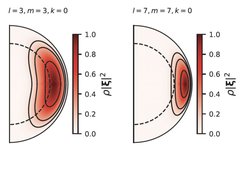
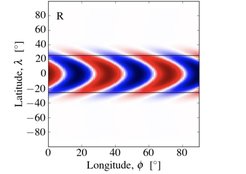
In a second problem, Gizon et al. (2020b) considered plane waves in a local Cartesian coordinate system near the equator to study the effect of latitudinal differential rotation on the modes. We found that the eigenfunctions are singular at critical latitudes near 20° to 30°. In the presence of eddy viscosity, the singularities are removed and the eigenfrequencies are complex and discrete. For reasonable values of the viscosity, all modes are stable. At fixed longitudinal wavenumber, the least damped mode is a symmetric mode with a real frequency close to that of the classical Rossby mode (Fig. B). The attenuation and the real part of the eigenfunction can be made to agree with the observations (unlike the imaginary part of the eigenfunction, which has a larger amplitude in the model). We conclude that each longitudinal wavenumber is associated with a latitudinally symmetric Rossby mode trapped at low latitudes by solar differential rotation. In this model, Rossby modes transport significant angular momentum from the dissipation layers towards the equator.
Helioseismic ring-diagram analysis by Proxauf et al. (2020) find that the horizontal eigenfunctions are symmetric across the equator, switch sign around latitudes of 20° to 30°, and decrease at higher latitudes. Eigenfunctions are slightly shaped like chevrons, pointing prograde for azimuthal wavenumbers m ≥ 4 and retrograde for m < 4. Proxauf et al. (2020) also found that the eigenfunctions do not decrease very sharply with depth just below the surface. Unfortunately, we were unable to decide whether a simple rm dependence is consistent with the observations, due to systematic errors in the data.
Much more work is needed both on the modeling and measurement of solar Rossby modes to find out about their potential to inform us about the dynamics of the solar convection zone. Rossby modes may even tell us about the inner workings of the solar dynamo through temporal variations of their properties on the 11-year time scale (Goddard et al. 2020).
[Go back to Research Topic and Recent Result, or to the top of this page ]
References:
- Damiani, C., Cameron, R. H., Birch, A. C., Gizon, L., Astron. Astrophys. 637, A65 (2020).
- Gizon, L., Fournier, D., Albekioni, M., Astron. Astrophys., Forthcoming article (2020b).
- Goddard, C. R., Birch, A. C., Fournier, D., Gizon, L., Astron. Astrophys. 640, L10 (2020).
- Hanson, C. S., Gizon, L., Liang, Z.-C., Astron. Astrophys. 635, A109 (2020).
- Liang, Z.-C., Gizon, L., Birch, A. C., Duvall, T. L., Astron. Astrophys. 626, A3 (2019).
- Löptien, B., Gizon, L., Birch, A. C., et al., Nature Astron. 2, 568 (2018).
- Proxauf, B., Gizon, L., Löptien, et al., Astron. Astrophys. 634, A44 (2020).
Solar active regions develop tilt after emergence
Magnetic activity regions provide two well-known constraints for dynamo models: Hale's law, which tells us that the magnetic polarities of larger active regions that emerge in the northern and southern hemispheres have opposite polarities, and Joy's law, which describes the observed statistical tendency of the leading polarity of an active region to be closer to the equator than the following polarity. This tilt angle between the leading and following polarities is observed to increase with unsigned latitude.
Active regions are thought to be the result of magnetic flux concentrations that form at the bottom of the convection zone and then buoyantly rise through the convection zone. Alternative ideas are that magnetic flux concentrations originate in the near-surface shear layer or are formed throughout the convection zone. In the first scenario, Joy's Law is driven by the Coriolis effect acting on the flows in an east-west oriented flux tube, driving a motion in the north-south direction so that the leading leg of the flux tube is tilted towards in the equatorward direction.
In Schunker et al. (2020) we tracked the motion of hundreds of active region polarities (see Schunker et al. 2016) as they emerged onto the surface of the Sun. We found that on average the polarities emerge east-west aligned (see Figure). This is surprising since thin flux tube models predict that tilt angles of rising flux tubes are generated below the surface. Further, the thin flux tube model predicts a dependence on flux since the flows will be faster in a region with higher flux, however, we do not observe any flux dependence in the measured tilt angles.
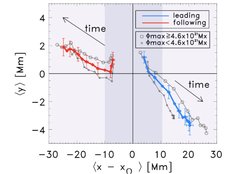
It had been observed that the tilt angle of active regions "relaxed" to a more east-west orientation after emergence. This was used to constrain the anchoring depth of sunspots being somewhere near the bottom of the convection zone. Because we have measured the east-west and north-south motions of the polarities independently (rather than measuring their motion relative to one another), we were able to show that this relaxation can be explained as a straightforward consequence of the increasing east-west separation of the polarities.
We found that on average, by two days after emergence with an east-west orientation, Joy's Law is clearly observed. Previously, Joy's Law has been interpreted as a twisting of the polarities about a common center. By analysing the east-west and north-south motion separately we found that the east-west separation is directly dependent on flux, but the north-south separation is not dependent on flux but is dependent on latitude. We conclude from this that Joy's Law is born out of an inherent
north-south motion of the polarities.
[Go back to Research Topic and Recent Result, or to the top of this page ]
References:
- Schunker, H., Baumgartner, C., Birch, et al., Astron. Astrophys. 640, A11 (2020).
- Schunker, H., Braun, D. C., Birch, A. C., et al., Astron. Astrophys. 595, A107 (2016).
Four billion years of solar-cycle irradiance variations
The solar dynamo generates magnetic fields in the solar interior. Where this magnetic field crosses the solar surface, it can cause various manifestations of magnetic activity. One example is changes in the Spectral Solar Irradiance (SSI). It is known that these variations have substantial impact on the Earth's atmosphere. The faster rotation of the Sun in the past led to a more vigorous dynamo and consequently larger amplitude of solar spectral irradiance variability. This may have caused a stronger effect of the SSI variability on the Earth.
In Anna Shapiro et al. (2020), we calculated the amplitude of the SSI variability over the course of the solar activity cycle (which presently lasts 11 years but could have had a different duration in the past) as a function of solar age. We used a recently published relationship between stellar chromospheric activity and stellar age (Lorenzo-Oliveira et al. 2018) to reconstruct solar chromospheric activity back in time. We also used this relation to reconstruct solar magnetic activity and the corresponding coverages of the solar disk by spots and faculae over the last four billion years (Shapiro et al. 2014). Then we used the SATIRE (Spectral And Total Irradiance Reconstruction) approach to compute the amplitude of brightness variations from our estimates of spot and faculae coverages.
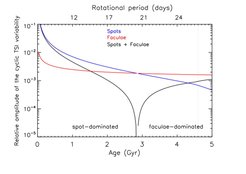
Our study shows that for the young Sun the variability of the Total Solar Irradiance (TSI, i.e. irradiance integrated over the entire spectral domain) was spotdominated, that is, the Sun was overall brighter at activity minima than at maxima (see Figure). The amplitude of the variability decreased as the Sun aged. At the solar age of about 2.8 Gyr the amplitude reached its minimum. After this point the variability changed from being spot- to faculardominated (the Sun is brighter at activity maximum) and its amplitude started to increase. Our calculations show that the amplitude of the TSI variability of 600-Myr Sun was one order of magnitude larger than the present-day value. These calculations of the past solar irradiance variability might be also of interest for paleoclimate and exoplanetary research.
[Go back to Research Topic and Recent Result, or to the top of this page ]
References:
- Lorenzo-Oliveira, D., Freitas, F. C., Meléndez, J., et al., Astron. Astrophys. 619, A10 (2018).
- Shapiro, A. I., Solanki, S. K., Krivova, N. A., et al., Astron. Astrophys. 569, A38 (2014).
- Shapiro, A. V., Shapiro, A. I., Gizon, L., et al., Astron. Astrophys. 636, A83 (2020).
Giant swirls on the Sun
Waves similar to those controlling weather on Earth have now been found on the Sun.
May 7, 2018
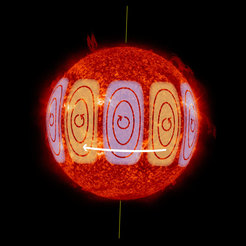
A team of scientists led by the Max Planck Institute for Solar System Research (MPS) and the University of Göttingen has discovered new waves of vorticity on the Sun. As described in today’s issue of Nature Astronomy, these Rossby waves propagate in the direction opposite to rotation, have lifetimes of several months, and maximum amplitudes at the Sun’s equator. For forty years scientists had speculated about the existence of such waves on the Sun, which should be present in every rotating fluid system. Now, they have been unambiguously detected and characterized for the first time. The solar Rossby waves are close relatives of the Rossby waves known to occur in the Earth’s atmosphere and oceans.
References:
Press Release:
Slow appearance of sunspots challenges theory
Scientists find that sunspots rise to the surface much more slowly than predicted
July 13, 2016

Solar active regions consist of strongly magnetic sunspots and surrounding regions of more diffuse magnetic field. These regions are the origin of solar activity which controls space weather and causes beautiful phenomena such as aurora but in some cases also damage to satellites or power grids. Solar active regions are thought to be the result of magnetic flux concentrations - bundles of magnetic field lines - rising from deep in the solar interior and penetrating the surface. A team consisting of researchers from the Max Planck Institute for Solar System Research (MPS), The University of Göttingen, NorthWest Research Associates, and the High Altitude Observatory of the National Center for Atmospheric Research has now shown that these magnetic flux concentrations move upward through the solar interior at speeds of not more than about 150 m/s. This is much slower than predicted by the prevailing current model. For their study, which is published today in the journal Science Advances, they compared satellite observations and computer simulations.
References:
Press Releases:





